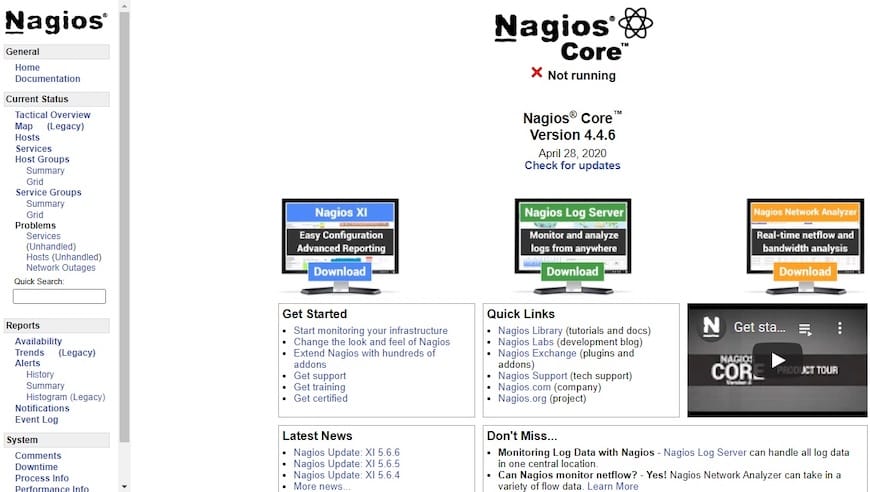
In this tutorial, we will show you how to install Nagios on CentOS 9 Stream. For those of you who didn’t know, Nagios Core, formerly known as Nagios, is a free and open-source computer-software application that monitors systems, networks, and infrastructure. It supports both Linux and Windows OS and provides an intuitive web interface that allows you to easily monitor network resources.
This article assumes you have at least basic knowledge of Linux, know how to use the shell, and most importantly, you host your site on your own VPS. The installation is quite simple and assumes you are running in the root account, if not you may need to add ‘sudo‘ to the commands to get root privileges. I will show you the step-by-step installation of the Nagios core monitoring tool on CentOS 9 Stream.
Prerequisites
- A server running one of the following operating systems: CentOS 9 Stream.
- It’s recommended that you use a fresh OS install to prevent any potential issues.
- SSH access to the server (or just open Terminal if you’re on a desktop).
- A
non-root sudo useror access to theroot user. We recommend acting as anon-root sudo user, however, as you can harm your system if you’re not careful when acting as the root.
Install Nagios on CentOS 9 Stream
Step 1. First, let’s start by ensuring your system is up-to-date.
sudo dnf clean all sudo dnf update sudo dnf install httpd httpd-tools php gcc glibc glibc-common gd gd-devel make net-snmp
Step 2. Create User and Group for Nagios.
Run the following command below to create a user and group Nagios:
useradd nagios groupadd nagcmd
After that, add both the Nagios and the apache users to the nagcmd group:
usermod -G nagcmd nagios usermod -G nagcmd apache
Step 3. Installing Nagios on CentOS 9 Stream.
By default, Nagios is not available on the CentOS 9 Stream base repository. Let’s download the latest version of Nagios and Nagios plugins from the official page using the following command below:
wget https://assets.nagios.com/downloads/nagioscore/releases/nagios-4.4.6.tar.gz wget https://nagios-plugins.org/download/nagios-plugins-2.2.1.tar.gz
Next, extract Nagios and Nagios Plugins:
tar -xvf nagios-4.4.6.tar.gz tar -xvf nagios-plugins-2.2.1.tar.gz
After that, we compile the Nagios from the source code:
cd nagios-4.4.6/ ./configure --with-command-group=nagcmd make all make install make install-init make install-commandmode make install-config
Once is complete, now we compile and install Nagios Plugin libraries using the following command below:
cd /root/nagios cd nagios-plugins-2.2.1/
Run Nagios Plugin configuration file:
./configure --with-nagios-user=nagios --with-nagios-group=nagios make all make install
Verify Nagios configuration files:
/usr/local/nagios/bin/nagios -v /usr/local/nagios/etc/nagios.cfg
Finally, enable Nagios services:
sudo systemctl enable nagios sudo systemctl enable httpd
Step 4. Configure Nagios.
Nagios places configuration files under the /usr/local/nagios/etc directory. Now we edit email alerts and configure the file /usr/local/nagios/etc/objects/contacts.cfg:
nano /usr/local/nagios/etc/objects/contacts.cfg
Replace the email address field to receive the notification:
define contact {
contact_name nagiosadmin ; Short name of user
use generic-contact ; Inherit default values from generic-contact template (defined above)
alias Nagios Admin ; Full name of user
email admin@idroot.us ; <--- **** CHANGE THIS TO YOUR EMAIL ADDRESS ****
}
Step 5. Configure Web Interface for Nagios.
First, run the following command to install the web interface:
make install-webconf
Next, we set a password for the web interface:
htpasswd -s -c /usr/local/nagios/etc/htpasswd.users nagiosadmin
Once you are done with the configuration, start Apache services:
sudo systemctl start httpd
Step 3. Configure Firewall.
Allow the firewall to port HTTP and HTTPS and reload it with the following commands:
sudo firewall-cmd --zone=public --add-port=80/tcp --permanent sudo firewall-cmd --zone=public --add-port=443/tcp --permanent sudo firewall-cmd --reload
Step 6. Accessing Nagios Web Interface.
Once successfully installed, open your web browser and access the Nagios Core using the URL http://your-IP-server/nagios. You will need to use the username (nagiosadmin) and password you specified earlier to access the Nagios web interface:

You will be redirected to the following page:

Congratulations! You have successfully installed Nagios. Thanks for using this tutorial to install Nagios Core on CentOS 9 Stream. For additional help or useful information, we recommend you check the official Nagios website.